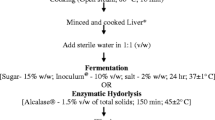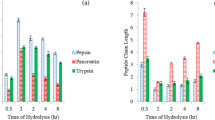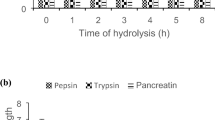Abstract
Proteins in delimed tannery fleshings were fermentatively hydrolysed using Enterococcus faecium NCIM5335 and also hydrolysed using mild organic acids (formic acid and propionic acid). The liquor portion containing hydrolysed proteins was spray dried, in both the cases, to obtain a powder. The spray dried powder was evaluated for in vitro antioxidant activities with respect to scavenging different free radicals and antibacterial properties against nine different pathogens. Fermentation and acid hydrolysates scavenged 83 and 75.3% of 2,2-azino-bis-3-ethyl-benzthiazoline-6-sulphonic acid (ABTS) radicals, respectively, at a protein concentration of 0.25 mg. Further, fermentation hydrolysate showed higher 2,2-diphenyl-1-picrylhydrazyl radical scavenging activity of 59% as compared to 56% scavenging by acid hydrolysate at a protein concentration of 5 mg. Acid hydrolysate exhibited lesser (82.3%) peroxy radical scavenging compared to hydrolysate from fermentation (88.2%) at a protein concentration of 10 mg. However, acid hydrolysate exhibited higher (89.2%) superoxide anion scavenging while its fermentation counterpart showed lower activity (85.4%) at 2.5 mg hydrolysate protein. Well as superoxide anion scavenging properties. All the in vitro antioxidant properties exhibited dose dependency. Fermentation hydrolysate exhibited maximum antagonistic activity against Salmonella typhi FB231, from among host of pathogens evaluated. Both the hydrolysates have potential to be ingredients in animal feeds and can help reduce oxidative stress in the animals.



Similar content being viewed by others
Abbreviations
- AAPH:
-
2,2′-azobis(2-methyl–propionamide)dihydrochloride
- ABTS:
-
2,2′-azino-bis-3-ethyl-benzthiazoline-6-sulphonicacid
- AH:
-
Acid hydrolysate
- BHI:
-
Brain heart infusion agar
- CFU:
-
Colony forming units
- DMW:
-
De-mineralized water
- DPPH:
-
2,2′-diphenyl-1-picrylhydrazyl
- GRAS:
-
Generally recognized as safe
- LAB:
-
Lactic acid bacteria
- LFH:
-
LAB fermented hydrolysate
- MRS Agar:
-
de Mann Rogosa and Sharpe agar
- PGR:
-
Pyrogallol red
- TF:
-
Tannery fleshings
- WWB:
-
Wet weight basis
References
Alexander KTW, Corning DR, Cory NJ, Donohue VJ, Sykes RL (1991) Enviornmental and safety issues-clean technology and environmental auditing. J Soc Leather Technol Chem 76:17–23
Amit KR, Bhaskar N, Halami Prakash M, Indirani K, Suresh PV, Mahendrakar NS (2009a) Characterization and application of a native lactic acid bacterium isolated from tannery fleshings for fermentative bioconversion of tannery fleshings. Appl Microbiol Biotechnol 83:757–766
Amit KR, Nived C, Sakhare PZ, Suresh PV, Bhaskar N, Mahendrakar NS (2009b) Optimization of acid hydrolysis of delimed tannery fleshings by response surface methodology. J Sci Ind Res 68:967–974
Amit KR, Thiyam G, Bhaskar N, Suresh PV, Sakhare PZ, Halami P, Mahendrakar NS (2010a) Utilization of tannery fleshing: Optimization of condition for fermenting delimed tannery fleshings using Entercoccus faecium HAB01 by response surface methodology. Bioresour Technol 101:1885–1891
Amit KR, Swapna HC, Bhaskar N, Halami PM, Sachindra NM (2010b) Effect of fermentation ensilaging on recovery of oil from fresh water fish viscera. Enz Microbiol Technol 46:9–13
AOAC (1995) Official methods of analysis. In: Helrich K (ed) Association of Analytical Chemists, 16th edn, Arlington
Arvanitoyannis IS (2007) Waste management for the food industries. Elsevier, Amsterdam, The Netherlands
Arvanitoyannis IS, Kassaveti A (2008) Fish industry waste: treatments, environmental impacts, current and potential uses. Int J Food Sci Technol 43:726–745
Arvanitoyannis IS, Ladas D (2008) Meat waste treatment methods and potential uses. Int J Food Sci Technol 43:543–559
Bernardeau M, Guguen M, Vernoux JP (2006) Beneficial lactobacilli in food and feed: long-term use biodiversity and proposal for specific and realistic safety assessments. FEMS Microbiol Rev 30:487–513
Bhaskar N, Sakhare PZ, Suresh PV, Lalitha RG, Mahendrakar NS (2007a) Biostabilisation and preparation of protein hydrolysates from delimed leather fleshing. J Sci Ind Res 66:1054–1063
Bhaskar N, Suresh PV, Sakhare PZ, Sachindra NM (2007b) Shrimp biowaste fermentation with Pediococcus acidolactici CFR2182: Optimization of fermentation conditions by response surface methodology and effect of optimized conditions on deproteination/demineralization and carotenoid recovery. Enz Microb Technol 40:1427–1434
Cheeseman KH, Slater TF (1993) An introduction to free radical biochemistry. Br Med Bull 49:481–493
Colak S, Zengin G, Ozgunay H, Sarikahya H, Sari O, Yuceer L (2005) Utilization of leather industry prefleshings in biodiesel production. J Am Leather Chem Assoc 100(3):137–141
Diplock AT (1997) Will the Ôgood fairiesÕ please prove to us that vitamin E lessens human degenerative disease? Free Rad Res 27:511–532
FDA (2009) Food additives status list: CFSAN/office of food additive safety, July 2006. http://www.cfsan.fda.gov/~dms/opa-appa.html (accessed on 18 February 2009)
Ganesan P, Chandini SK, Bhaskar N (2008) Antioxidant properties of methanol extract and other solvent fractions obtained from selected Indian red seaweed. Biores Technol 99:2717–2723
Gediminas BA, Olga KV, Jurgita K (2006) Food-Protein enzymatic hydrolysates posseses both antimicrobial and immunostimulatory activities : a cause and effect theory of biofunctionality. FEMS Immuno Med Microbiol 46:131–138
Geis AJ, Singh R, Teuber MJ (1983) Potential of lactic streptococci to produce bactericin. Appl Environ Microbiol 45:205–211
Heo SJ, Park EJ, Lee KW, Jeon YJ (2005) Antioxidant activities of enzymatic extracts from brown seaweeds. Biores Technol 96:1613–1623
Kawai K, Shimazaki K, Higuchi H, Nagahata H (2007) Antibacterial activity of bovine lactoferrin hydrolysate against mastitis pathogens and its effect on superoxide roduction of bovine neutrophils. Zoo Pub Health 54:160–164
Kristinssons HG, Rasco BA (2000) Fish protein hydrolysates: production, biochemical and functional properties. Crit Rev Food Sci Nutr 40:43–81
Kumar AG, Swarnalatha S, Sairam B, Sekaran G (2008) Production of alkaline protease by Pseudomonous aeruginosa using proteinaceous solid waste generated from leather manufacturing industries. Biores Technol 99:1939–1944
LeBlanc JG, Matar C, Valdez JC, LeBlanc J, Perdigo NG (2002) Immunomodulating effects of peptidic fractions issued from milk fermented with Lactobacillus helveticus. J Dairy Sci 85:2733–2742
Lopez-Alarcon C, Lissi E (2005) Interaction of pyrogallol red with peroxyl radicals. A basis for a simple methodology for the evaluation of antioxidant capabilities. Free Rad Res 39:729–736
Lowry OH, Fan AL, Randall RJ, Rosebrough NJ (1951) Protein measurement with Folin phenol reagent. J Biol Chem 193:256–275
Macdonald J, Galley HF, Webster NR (2003) Oxidative stress and gene expression in sepsis. Brit J Anaesthesia 90:221–232
Sachindra NM, Bhaskar N (2008) In vitro antioxidant activity of liquor from fermented shrimp biowaste. Bioresour Technol 99:9013–9016
Simeonova LS, Dalev PG (1997) Utilization of leather industry waste. Waste Manage 16:765–769
Song L, Li T, Yu R, Yan C, Ren S, Zhao Y (2008) Antioxidant activities of hydrolysates of Arca subcrenata prepared with three proteases. Marine Drugs 6:607–619
Suetsuna K, Maekawa K, Chen J (2004) Antihypertensive effects of Undaria pinnatifida (wakame) peptide on blood pressure in spontaneously hypertensive rats. J Nutr Biochem 15:267–272
Tsuruki T, Kishi K, Takahashi M, Tanaka M, Matsukawa T, Yoshikawa M (2003) Soymetide, an immunostimulating peptide derived from soybean b-conglycinin, is an Fmlp agonist. FEBS Lett 540:206–210
Wu KC, Lin ZY, Chiang SH, Chang CY (2004) Antioxidant properties of porcine blood protein before and after enzymatic hydrolysis. J Biomass Ener Soc China 23:79–85
Acknowledgments
This study is supported by funding from Council of Scientific and Industrial Research (CSIR) through the network program (NWP-044) on Zero Emission Research Initiatives (ZERI). We thankfully acknowledge Masood Ahmed of M/s Mysore Super Reptiles Corporation, Bangalore, Karnataka, India for the gratis supply of limed TF. Authors thank Prakash V, Director, CFTRI, for encouragement and permission to publish this study.
Author information
Authors and Affiliations
Corresponding author
Rights and permissions
About this article
Cite this article
Balakrishnan, B., Prasad, B., Rai, A.K. et al. In vitro antioxidant and antibacterial properties of hydrolysed proteins of delimed tannery fleshings: comparison of acid hydrolysis and fermentation methods. Biodegradation 22, 287–295 (2011). https://doi.org/10.1007/s10532-010-9398-0
Received:
Accepted:
Published:
Issue Date:
DOI: https://doi.org/10.1007/s10532-010-9398-0




